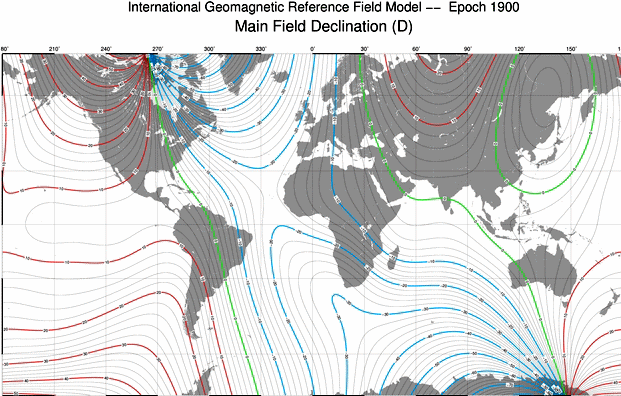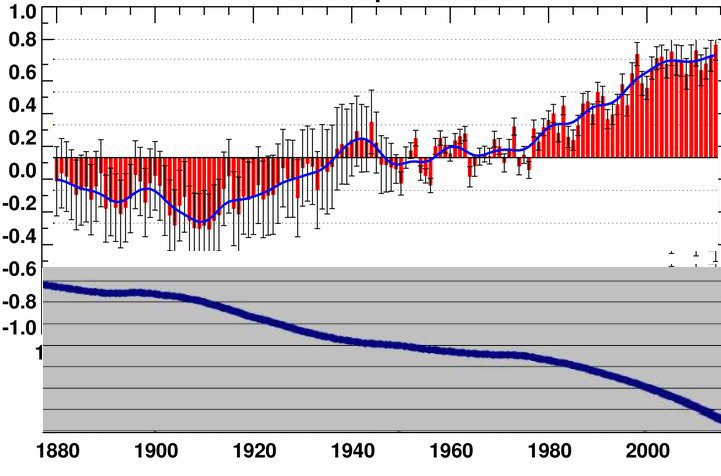Sunday, May 15, 2016
Still trying
Still trying to parse out the possible connection between magnetic changes, bacteria, and weather patterns.
 This GIF is made from the maps available here, showing magnetic declination from 1900 to 2000. Overall nothing dramatic; the two poles of the magnet are gradually moving, carrying the lines with them. The lines over USA move one way then the other, ending in 2000 about where they were in 1900. This agrees with a lot of weather patterns. Only one area seems to be moving steadily and comparatively fast: the south Atlantic between Brazil and Africa. This is where the Gulf Stream gets organized, and the Gulf Stream is definitely changing.
= = = = =
Here's a more meaningful graph. I took a NOAA overall temperature graph and added total magnetic field intensity on the same years.
This GIF is made from the maps available here, showing magnetic declination from 1900 to 2000. Overall nothing dramatic; the two poles of the magnet are gradually moving, carrying the lines with them. The lines over USA move one way then the other, ending in 2000 about where they were in 1900. This agrees with a lot of weather patterns. Only one area seems to be moving steadily and comparatively fast: the south Atlantic between Brazil and Africa. This is where the Gulf Stream gets organized, and the Gulf Stream is definitely changing.
= = = = =
Here's a more meaningful graph. I took a NOAA overall temperature graph and added total magnetic field intensity on the same years.
 To show the close match in PHASE between the two, I flipped the temp graph:
To show the close match in PHASE between the two, I flipped the temp graph:
 No doubt about it. These two measurements are speeding up and slowing down at the same times. They are in phase.
Good old 1974. Inflection point for everything.
This reinforces the magnetosphere connection, but complicates the Svensmark mechanism for the magnetosphere connection. Svensmark says that decreasing magnetic field lets in more cosmic rays, which nucleate more clouds and rain, which cool the surface. However, if we note that much of the warming is in the form of warmer nights, not warmer days, Svensmark is back in the running. (More cloud = more blanket.)
Simpler mechanism: Mag strength is decreasing because the iron core is getting hotter. More wiggles in the iron molecules = less alignment. Hotter core also = hotter surface, and also = more volcanic and seismic activity.
No doubt about it. These two measurements are speeding up and slowing down at the same times. They are in phase.
Good old 1974. Inflection point for everything.
This reinforces the magnetosphere connection, but complicates the Svensmark mechanism for the magnetosphere connection. Svensmark says that decreasing magnetic field lets in more cosmic rays, which nucleate more clouds and rain, which cool the surface. However, if we note that much of the warming is in the form of warmer nights, not warmer days, Svensmark is back in the running. (More cloud = more blanket.)
Simpler mechanism: Mag strength is decreasing because the iron core is getting hotter. More wiggles in the iron molecules = less alignment. Hotter core also = hotter surface, and also = more volcanic and seismic activity.
 This GIF is made from the maps available here, showing magnetic declination from 1900 to 2000. Overall nothing dramatic; the two poles of the magnet are gradually moving, carrying the lines with them. The lines over USA move one way then the other, ending in 2000 about where they were in 1900. This agrees with a lot of weather patterns. Only one area seems to be moving steadily and comparatively fast: the south Atlantic between Brazil and Africa. This is where the Gulf Stream gets organized, and the Gulf Stream is definitely changing.
= = = = =
Here's a more meaningful graph. I took a NOAA overall temperature graph and added total magnetic field intensity on the same years.
This GIF is made from the maps available here, showing magnetic declination from 1900 to 2000. Overall nothing dramatic; the two poles of the magnet are gradually moving, carrying the lines with them. The lines over USA move one way then the other, ending in 2000 about where they were in 1900. This agrees with a lot of weather patterns. Only one area seems to be moving steadily and comparatively fast: the south Atlantic between Brazil and Africa. This is where the Gulf Stream gets organized, and the Gulf Stream is definitely changing.
= = = = =
Here's a more meaningful graph. I took a NOAA overall temperature graph and added total magnetic field intensity on the same years.
 To show the close match in PHASE between the two, I flipped the temp graph:
To show the close match in PHASE between the two, I flipped the temp graph:
 No doubt about it. These two measurements are speeding up and slowing down at the same times. They are in phase.
Good old 1974. Inflection point for everything.
This reinforces the magnetosphere connection, but complicates the Svensmark mechanism for the magnetosphere connection. Svensmark says that decreasing magnetic field lets in more cosmic rays, which nucleate more clouds and rain, which cool the surface. However, if we note that much of the warming is in the form of warmer nights, not warmer days, Svensmark is back in the running. (More cloud = more blanket.)
Simpler mechanism: Mag strength is decreasing because the iron core is getting hotter. More wiggles in the iron molecules = less alignment. Hotter core also = hotter surface, and also = more volcanic and seismic activity.
No doubt about it. These two measurements are speeding up and slowing down at the same times. They are in phase.
Good old 1974. Inflection point for everything.
This reinforces the magnetosphere connection, but complicates the Svensmark mechanism for the magnetosphere connection. Svensmark says that decreasing magnetic field lets in more cosmic rays, which nucleate more clouds and rain, which cool the surface. However, if we note that much of the warming is in the form of warmer nights, not warmer days, Svensmark is back in the running. (More cloud = more blanket.)
Simpler mechanism: Mag strength is decreasing because the iron core is getting hotter. More wiggles in the iron molecules = less alignment. Hotter core also = hotter surface, and also = more volcanic and seismic activity.
Labels: Carbon Cult
